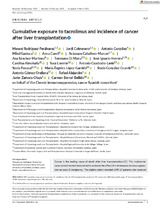Cumulative exposure to tacrolimus and incidence of cancer after liver transplantation
Autor
Rodríguez-Perálvarez, Manuel
Colmenero, Jordi
González, Antonio
Gastaca, Mikel
Curell, Anna
Caballero-Marcos, Aránzazu
Sánchez-Martínez, Ana
Maira, Tommaso Di
Herrero, José Ignacio
Almohalla, Carolina
Lorente, Sara
Cuadrado-Lavín, Antonio
Pascual, Sonia
López-Garrido, María Ángeles
González-Grande, Rocío
Gómez-Orellana, Antonio Manuel
Alejandre, Rafael
Zamora-Olaya, Javier
Bernal-Bellido, Carmen
Chronic immunosuppression, cancer Spanish consortium
Editor
WileyFecha
2022Materia
Hepatocellular carcinomaImmunosuppression
Malignancy
Neoplasm
Tacrolimus
METS:
Mostrar el registro METSPREMIS:
Mostrar el registro PREMISMetadatos
Mostrar el registro completo del ítemResumen
Cancer is the leading cause of death after liver transplantation (LT). This multicenter case–control nested study aimed to evaluate the effect of maintenance immunosuppression on post-LT malignancy. The eligible cohort included 2495 LT patients who received tacrolimus-based immunosuppression. After 13 922 person/years follow-up, 425 patients (19.7%) developed malignancy (cases) and were matched with 425 controls by propensity score based on age, gender, smoking habit, etiology of liver disease, and hepatocellular carcinoma (HCC) before LT. The independent predictors of post-LT malignancy were older age (HR = 1.06 [95% CI 1.05–1.07]; p < .001), male sex (HR = 1.50 [95% CI 1.14–1.99]), smoking habit (HR = 1.96 [95% CI 1.42–2.66]), and alcoholic liver disease (HR = 1.53 [95% CI 1.19–1.97]). In selected cases and controls (n = 850), the immunosuppression protocol was similar (p = .51). An increased cumulative exposure to tacrolimus (CET), calculated by the area under curve of trough concentrations, was the only immunosuppression-related predictor of post-LT malignancy after controlling for clinical features and baseline HCC (CET at 3 months p = .001 and CET at 12 months p = .004). This effect was consistent for de novo malignancy (after excluding HCC recurrence) and for internal neoplasms (after excluding non-melanoma skin cancer). Therefore, tacrolimus minimization, as monitored by CET, is the key to modulate immunosuppression in order to prevent cancer after LT.

